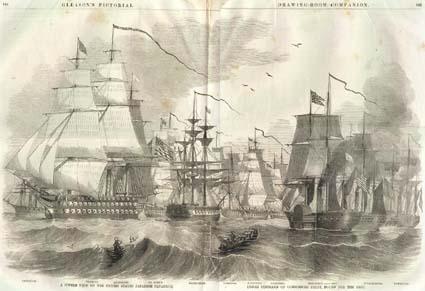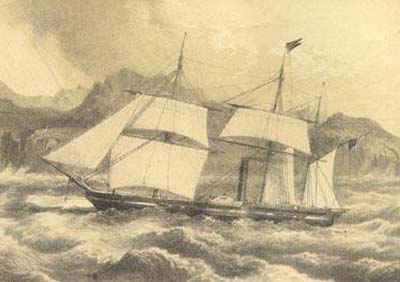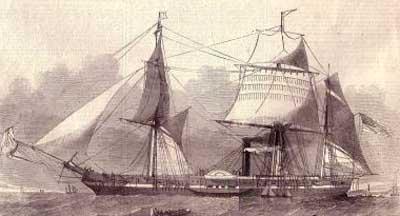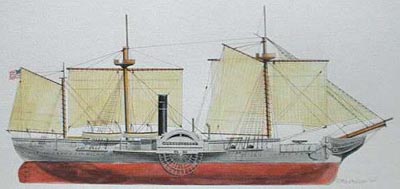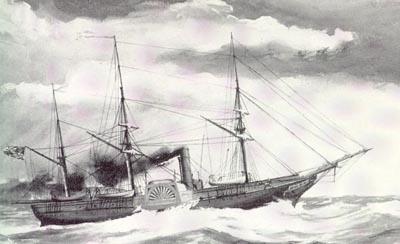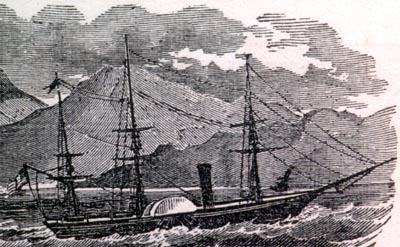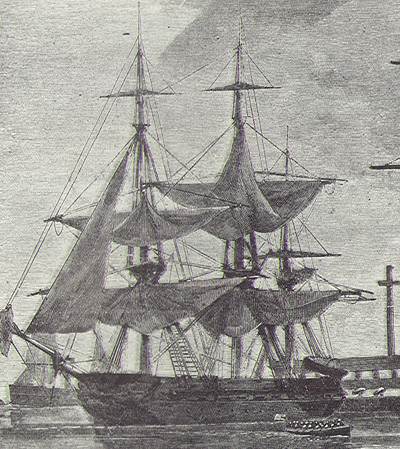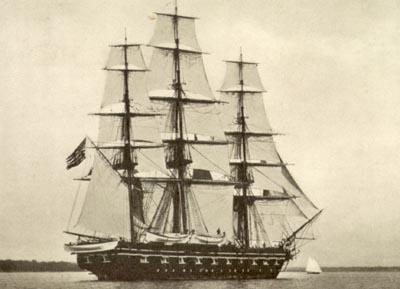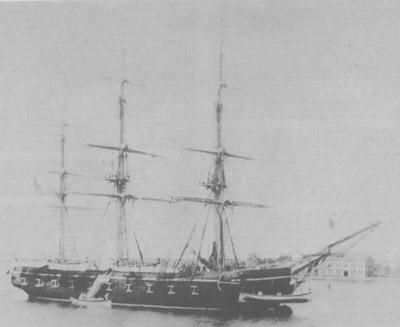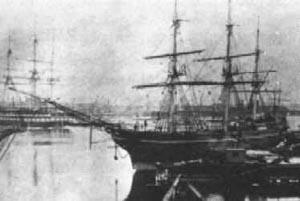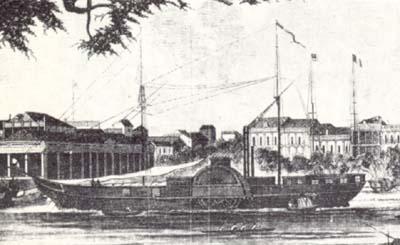Ships of Commodore Perry's Squadron
Total for Actual Squadron (fewer ships than shown above) Ships of the Squadron, First Landing in Japan (July, 1853)
1. Mississippi
1. Mississippi 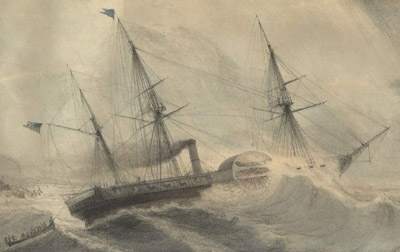 Naval Scenes in the Mexican War by H. Walke, Lieut. U.S. Navy, 1847
Picture of Model of the Ship
Complement: 268 The Mississippi was a wood hull, paddle wheel, barque-rigged, steam frigate. She was 229 feet long, 40 foot at the beam and had a draft of 19 feet. She had 19,000 square feet of canvas. The Mississippi had side lever engines with cylinders 75 inches in diameter with 7 foot stroke. She was built in the Philadelphia Navy Yard in 1839-41 under the personal supervision of Commodore Matthew C. Perry. Commodore Perry has became know as the father of the steam Navy because of his strong commitment to introducing steam ships in to the Navy. The first US Navy steam ship was the Fulton. The Mississippi and her sister ship, the Missouri, were the U.S. Navy's first ocean-going side-wheeled steamers and it's first ocean-going steam driven capital ships. Because the reliability of steam was still unknown, the ship also had sails. The smokestack was aft of the paddlewheels. In many other steam frigates the smokestack is located in front of the paddlewheels. The Mississippi was commissioned on December 22, 1841. In 1845 she sailed as Perry's flagship in the West Indian Squadron during the Mexican War, and she took part in the blockade of Mexican Gulf and Caribbean coast ports, as well as in the capture of Vera Cruz, Tuxpan, and Tabasco in 1847. The Mississippi sailed as the cornerstone ship in Perry's Squadron on his expedition to open Japan (1852-4). Joining Farragut's fleet for the assault on New Orleans on April 7, 1863, she became the largest vessel to cross the bar of the river whose name she bore. As the Union fleet ran past Forts Jackson and St. Philip, Mississippi destroyed CSS Manassas before proceeding to New Orleans where she remained until 1863. Farragut then ordered her to take part in the run past Port Hudson. On March 14, 1863, she had just passed Port Hudson when she ran aground. She came under devastating fire that killed 64 of her crew. She was ordered to be set afire and abandoned.
The Susquehanna was a rigged side-wheel steamer. Her keel was laid in 1847 and she was launched on April 5, 1850. She was widely considered a very inefficient ship and even described at the time as a "technological monstrosity." The Susquehanna was assigned to the Far East Station arriving at Hong Kong on February 5, 1852. The ship and Squadron was under the Command of Commodore John Henry Aulick who had orders to negotiate a treaty with Japan. These orders were subsequently rescinded and Aulick relieved of command and returned to the United States. Commodore Perry completed Aulick's mission and the Susquehanna saw service in that expedition. At the termination of the Perry Expedition, she left Japanese waters in March of 1854 but remained on the China coast and subsequently returned to the United States via the Indian Ocean and the Cape of Good Hope. She arrived in Philadelphia on March 10, 1855 and was quickly decommissioned. She was recommissioned in 1856 and later saw service in the Civil War. She was finally decommissioned in 1868 and sold for scrap in 1883.
The Powhatan, a rigged side-wheel steamer, was built in Gosport, VA (Norfolk) and completed in 1852. Under Commodore William J. McCluney, it was assigned to the East India Squadron and arrived on station via Cape of Good Hope June 15, 1853. Her arrival in Chinese waters coincided with an important phase of Commodore Matthew C. Perry's negotiations for commercial relations with the Japanese and the opening of two ports. She was Perry's flagship during his November visit to Whampoa. On February 14, 1854 she entered Yedo (Tokyo) Bay with the rest of the squadron and was Perry's flagship when the treaty was signed March 31. The Powhatan served throughout the civil war. She was commissioned September 2, 1852 and decommissioned on June 2, 1886.
This is the second Macedonia. She was a 36-gun frigate. She was rebuilt from the keel of the first Macedonian at Gosport (later Norfolk) Navy Yard, Portsmouth, Va., beginning in 1832 and launched and placed in service in 1836. In 1852 Macedonian docked at the Brooklyn Navy Yard and converted to a sloop-of-war for the expedition to Japan, 1852 to 1854. She was decommissioned and sold to commercial interests in 1871.
On Valentine's Day 1853 the Vandalia was ordered to join the Perry Expedition and soon joined Perry's East Indies Squadron. She was present at Commodore Perry's entrance into Tokyo Bay on February 14, 1854. The Vandalia was laid down at the Philadelphia Navy Yard in 1825, launched in 1828 and commissioned on November 6, 1828. She was rebuilt in Philadelphia in 1848 and decommissioned February 4, 1863.
The Plymouth was built in Boston in 1843. It was burned and scuttled at Norfolk, VA in April of 1861.
The Saratoga was built in Portsmouth in 1843 and sold in 1907.
The Southampton was built in Norfolk in 1842 and sold before the Civil War. The Supply was delivered to the government at the Boston Navy Yard on December 8, 1846. She served with Perry's fleet during the Mexican American War as well as the Expedition to Japan. An interesting footnote in the Supply's history was her voyage in 1856 from Smyrna, Syria to Indianola, Texas, with a load of 30+ camels for experimental use in the American desert west of the Rockies. The famous (infamous) Camel Cavalry was headquartered just south of Kerrville, TX at Camp Verde and eventually swelled to over 70 camels. It was commanded by Major Henry C. Wayne. Unfortunately, the camels could not take the Texas heat (well actually rocky terrain) and the experiment failed. Watch out for those wild hill country camels. The Supply was decommissioned in New York on April 28, 1879 and sold in 1884.
The Lexington was built in New York in 1826 and subsequently rebuilt in New York in 1843. She was decommissioned in 1855. The barque Caprice was chartered as a collier. I have seen it referred to as the USS Caprice. However, I believe it was a private ship, under government contract. The Queen was a small privately owned steamship that Commodore Perry charted in Hong Kong for $500.00 a month. The ship was owned by a British citizen residing in Hong Kong. Perry armed and manned this ship from his squadron and used the ship to protect US citizens in the coastal war against Chinese pirates. The Queen was positioned to protect American merchants in Canton. The Vincennes, John Hancock and Fenimore Cooper from the Command of Commander Cadwallader Ringgold later joined the Queen in this mission. While the Queen did not take part in the expedition to Japan per se, it did free up Naval assets for the expedition and is therefore mentioned here. The Preble Diary is a good source of information about the Queen. Source of Complement, Tonnage, Guns:
Perry, Commodore M. C., Actual crew (Complement) and the above figures are not precise for the Expedition. The actual crew number was clearly much less than these figures. In addition, the figures do not include the Marines embarked on the ships. It is interesting to compare the above figures, which are probably the most accurate, with the statistics widely published in a popular newspaper of 1853. Below are the figures (much higher than actual) that the general public probably believed represented the strength of the expedition.
Detailed Ship Information - US Navy Library
|
||||||||||||||||||||||||||||||||||||||||||||||||||||||||||||||||||||||||||||||||||||
